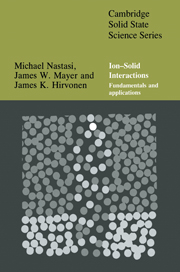Book contents
- Frontmatter
- Contents
- List of symbols
- Preface
- Chapter 1 General features and fundamental concepts
- Chapter 2 Interatomic potentials
- Chapter 3 Dynamics of binary elastic collisions
- Chapter 4 Cross-section
- Chapter 5 Ion stopping
- Chapter 6 Ion range and range distribution
- Chapter 7 Radiation damage and spikes
- Chapter 8 Ion–solid simulations and diffusion
- Chapter 9 Sputtering
- Chapter 10 Order–disorder and ion implantation metallurgy
- Chapter 11 Ion beam mixing
- Chapter 12 Phase transformations
- Chapter 13 Ion beam assisted deposition
- Chapter 14 Applications of ion beam processing techniques
- Chapter 15 Ion beam system features
- Appendix A Crystallography
- Appendix B Table of the elements
- Appendix C Density of states
- Appendix D Derivation of the Thomas–Fermi differential equation
- Appendix E Center-of-mass and laboratory scattering angles
- Appendix F Miedema's semi-empirical model for the enthalpy of formation in the liquid and solid states
- Appendix G Implantation metallurgy – study of equilibrium alloys
- Appendix H Physical constants, conversions and useful combinations
- Index
Chapter 8 - Ion–solid simulations and diffusion
Published online by Cambridge University Press: 27 January 2010
- Frontmatter
- Contents
- List of symbols
- Preface
- Chapter 1 General features and fundamental concepts
- Chapter 2 Interatomic potentials
- Chapter 3 Dynamics of binary elastic collisions
- Chapter 4 Cross-section
- Chapter 5 Ion stopping
- Chapter 6 Ion range and range distribution
- Chapter 7 Radiation damage and spikes
- Chapter 8 Ion–solid simulations and diffusion
- Chapter 9 Sputtering
- Chapter 10 Order–disorder and ion implantation metallurgy
- Chapter 11 Ion beam mixing
- Chapter 12 Phase transformations
- Chapter 13 Ion beam assisted deposition
- Chapter 14 Applications of ion beam processing techniques
- Chapter 15 Ion beam system features
- Appendix A Crystallography
- Appendix B Table of the elements
- Appendix C Density of states
- Appendix D Derivation of the Thomas–Fermi differential equation
- Appendix E Center-of-mass and laboratory scattering angles
- Appendix F Miedema's semi-empirical model for the enthalpy of formation in the liquid and solid states
- Appendix G Implantation metallurgy – study of equilibrium alloys
- Appendix H Physical constants, conversions and useful combinations
- Index
Summary
Introduction
The previous chapters have used analytical approaches to ion–solid interactions: ion ranges and radiation damage. Here, we discuss the use of computer simulations to describe the slowing down and scattering of energetic ions in solids. Two different types of computer simulations will be examined: Monte Carlo (MC) and molecular dynamics (MD). The Monte Carlo method relies on a binary collision model, and molecular dynamics solves the many-body problem of Newtonian mechanics for many interacting particles. Eckstein (1991) provides a review of computer simulation of ion–solid interactions.
The defects generated in ion–solid interactions influence the kinetic processes that occur both inside and outside the cascade volume. At times long after the cascade lifetime (t > 10−11 s), the remaining vacancy–interstitial pairs can contribute to atomic diffusion processes. This process, commonly called radiation enhanced diffusion (RED), can be described by rate equations and an analytical approach. Within the cascade itself, under conditions of high defect densities, local energy depositions exceed 1 eV/atom, and local kinetic processes can be described on the basis of a liquid-like diffusion formalism.
Monte Carlo simulations
The Monte Carlo methods, applied to ion–solid interactions, have a number of distinct advantages over analytical calculations based on transport theory. The MC approach allows for a more rigorous treatment of elastic scattering and of the determination of angular and energy distributions. As the name MC suggests, the results require averaging over many simulated particle trajectories.
- Type
- Chapter
- Information
- Ion-Solid InteractionsFundamentals and Applications, pp. 191 - 217Publisher: Cambridge University PressPrint publication year: 1996
- 1
- Cited by



